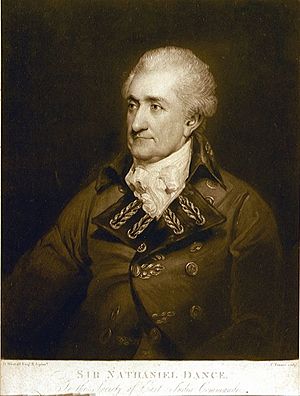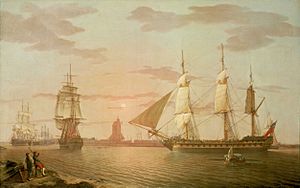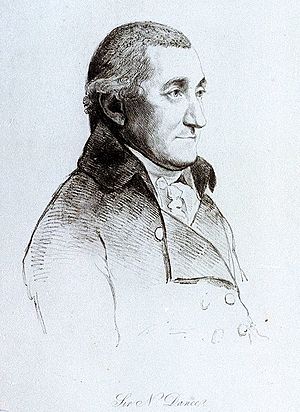Nathaniel Dance facts for kids
Quick facts for kids
Sir Nathaniel Dance
|
|
|---|---|
 |
|
| Born | 20 June 1748 London, England |
| Died | 25 March 1827 (aged 78) Enfield, England |
| Allegiance | United Kingdom of Great Britain and Ireland |
| Service/ |
East India Company |
| Years of service | 1759–1804 |
| Rank | Commodore |
| Battles/wars | French Revolutionary Wars Napoleonic Wars Battle of Pulo Aura |
| Awards | Knighthood |
Sir Nathaniel Dance (born June 20, 1748 – died March 25, 1827) was a brave officer who worked for the East India Company. This was a very powerful British trading company. He spent many years sailing on their large merchant ships, called "East Indiamen," to India and back.
Nathaniel Dance knew how risky these voyages were. In 1780, a combined French and Spanish fleet captured his ship. But his most famous moment came during the Napoleonic Wars. He was in charge of a group of East India Company ships, acting as their commodore.
He met a French squadron (a group of warships) led by Rear-Admiral Comte de Linois. The French were attacking British ships. Through clever sailing and bold actions, Dance tricked the French commander. He made Linois believe that his merchant ships were actually powerful warships.
The French decided not to attack the convoy (the group of ships traveling together). Dance then surprised them even more. He used his lightly armed merchant ships to chase the French warships away! This was amazing because the French had much stronger ships. Dance saved the valuable convoy from being captured. He became a hero and received many rewards, including a special title called a knighthood. He lived out his life in comfort.
Contents
Early Life and Sailing Career
Nathaniel Dance was born in London on June 20, 1748. His father was a lawyer. After Nathaniel was born, his father left the family. Nathaniel and his family were then looked after by his grandfather, George Dance the Elder. His grandfather was a well-known architect in London.
In 1759, when Nathaniel was about 11, he went to sea. He had help from Nathaniel Smith, an important person in the Honourable East India Company. With this support, Dance quickly moved up in the company. By 1780, he had sailed to India eight times. He also made trips to the Mediterranean and the West Indies.
On his ninth trip to India, his ship, the Royal George, was captured by French and Spanish ships. Dance was taken to Spain and spent six months there. Later, he became the commander of the ship Lord Camden in 1787. He made four more trips to India on this ship. In 1802, he became commander of a new ship, Earl Camden, and sailed her to China in 1803.
The Journey Home

The Earl Camden left Canton (now Guangzhou, China) on January 31, 1804. It was part of a large fleet heading back to England. Because he was the most senior captain, Dance was chosen to be the commodore. He was in charge of 11 "country" ships and 16 East Indiamen.
This fleet was carrying extremely valuable goods. Their cargo was worth about £8 million, which would be hundreds of millions of pounds today! Dance had been very sick on the way out, but he recovered in time for the return journey. The fleet did not have any warships from the navy to protect them.
Even though the East Indiamen were armed with 30 to 36 guns, they were not as strong as real warships. Sometimes, they didn't even carry all their guns. To make them look more powerful, they often painted fake gunports on their sides. This made them look like bigger, more powerful ships from the Royal Navy from a distance.
As the fleet got close to the Strait of Malacca on February 14, Dance's convoy had grown even larger. It included 16 East Indiamen, 11 country ships, a Portuguese merchant ship, and a ship from Australia. The East India Company had given them a small armed ship called Ganges. But this ship was only good for scaring off pirates, not fighting a French warship.
Near the entrance to the straits, suspicious sails were spotted. Dance sent some of his ships to check. They soon found out it was Linois's French squadron. This group included the large 74-gun ship Marengo. It also had two heavy frigates (medium-sized warships), a corvette (a smaller warship), and a Dutch brig (a small, fast ship).
The Battle of Pulo Aura
After realizing who the ships were, Dance told his merchant ships to get into a battle line. They kept sailing forward, and the French ships came closer but didn't attack. Dance used this time to arrange his ships. He put the stronger East Indiamen between the French and the weaker country ships.
The merchant ships kept moving towards the straits. Linois followed, trying to figure out how strong the convoy was. There were more ships than he expected. Dance's clever moves and the painted gunports made Linois think that several warships were protecting the convoy.
His suspicions seemed confirmed on February 15. Both sides raised their flags. Dance ordered the Ganges and four lead ships to fly blue flags. The rest of the convoy raised red flags. In the British flag system at the time, blue flags meant they were warships from Admiral Peter Rainier's squadron. Red flags meant they were merchant ships under their protection.
On the morning of February 16, the French still seemed unwilling to attack. Dance then ordered his ships to speed up by changing their sailing formation. This made the convoy look less threatening. Linois decided it was time to attack.
By the afternoon, the French ships were moving to cut off the ships at the back of the convoy. Dance quickly raised his flags. He ordered his largest ships, led by the East Indiamen Royal George, Ganges, and his own ship, Earl Camden, to turn around and move towards the French.
They sailed quickly towards the French, taking fire (shots) from them. Then, they fired their own broadsides (all the guns on one side of the ship) at close range. At this, the French gave up their attack. They turned and sailed away very fast. Dance then ordered a general chase! His merchant fleet chased the French squadron for two hours.
Finally, Dance stopped the chase and returned to his original course. The fleet continued towards the Malacca Strait. On February 28, they met two British warships from Admiral Peter Rainier's fleet. These warships escorted them as far as Saint Helena. There, the convoy met other British merchant ships. Royal Navy warships then escorted them all the way to Britain, where they arrived in August 1804.
Hero's Welcome and Rewards
The fact that a group of merchant ships not only escaped a French squadron without losing any ships, but also attacked and chased them away, was seen as a huge victory.

The Naval Chronicle, a newspaper about the navy, praised Dance greatly. They said his coolness, bravery, and skill were like that of the most experienced admirals. They also said the other captains and sailors followed his orders with great passion.
Dance received many rewards. The Bombay Insurance Company gave him £5,000, which was a huge amount of money then. He also got a pension of £500 a year for the rest of his life. The East India Company gave him valuable silver items and a special sword worth £100.
Captain Timmins of the Royal George received £1,000, a sword, and silver. The other captains received £500, a sword, and silver. Money was also given to the officers and sailors. An ordinary sailor received £6, which was a good amount for them.
Dance himself said that the actions of everyone under his command were important for the victory. He wrote that he was lucky to be in charge and that the bravery of his crew helped him succeed. He felt that the public had praised him more than he deserved.
Nathaniel Dance received a knighthood, which meant he was called "Sir Nathaniel Dance." He retired comfortably and passed away in Enfield on March 25, 1827, at the age of 78.


